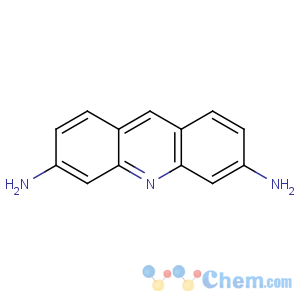Title: Proflavine
CAS Registry Number: 92-62-6
CAS Name: 3,6-Acridinediamine
Synonyms: 3,6-diaminoacridine; 2,8-diaminoacridine
Molecular Formula: C13H11N3
Molecular Weight: 209.25
Percent Composition: C 74.62%, H 5.30%, N 20.08%
Literature References: Prepn: M. Sch?pff,
Ber. 27, 2320 (1894);
DE 230412 (1910 to Cassella),
C.A. 5, 2734 (1911); W. P. Thompson,
GB 137214 (1919 to Poulenc Frères),
C.A. 14, 1445 (1920); A. Albert,
J. Chem. Soc. 1941, 121, 484;
1947, 244. Toxicity study: S. D. Rubbo,
Br. J. Exp. Pathol. 28, 1 (1947).
Review: The Acridines, A. Albert, Ed. (St. Martin's Press, New York, 2nd ed., 1966) pp 300-302;
Acridines, R. M. Acheson, Ed. (Interscience, New York, 1956) pp 341-344.
Properties: Yellow needles from alc, mp 281° (Sch?pff), mp 288° (Albert). Sol in water, ethanol. Practically insol in benzene, ether. pKa 9.7. Solns are brownish and when diluted are fluorescent.
Solns should be discarded when they become turbid. LD50 s.c. in mice: 0.14 g/kg (Rubbo).
Melting point: mp 281° (Sch?pff); mp 288° (Albert)
pKa: pKa 9.7
Toxicity data: LD50 s.c. in mice: 0.14 g/kg (Rubbo)
Derivative Type: Dihydrochloride
CAS Registry Number: 531-73-7
Molecular Formula: C13H11N3.2HCl
Molecular Weight: 282.17
Percent Composition: C 55.34%, H 4.64%, N 14.89%, Cl 25.13%
Properties: Orange-yellow needles. pH of 0.1% soln 2.5-3.0.
Derivative Type: Sulfate
CAS Registry Number: 553-30-0
Synonyms: Proflavine hemisulfate; neutral proflavine sulfate
Molecular Formula: C13H11N3.H2SO4
Molecular Weight: 307.33
Percent Composition: C 50.81%, H 4.26%, N 13.67%, S 10.43%, O 20.82%
Properties: Occurs as the hydrate. Red needles, hygroscopic. Sol in 300 parts cold water, in 1 part boiling water; slightly sol in alc. Practically insol in ether, CHCl3. pH of satd soln is 6-8. pH of 0.1% soln is 2.5.
Derivative Type: Mixture with 3,6-diamino-10-methylacridinium chloride
see Acriflavine
Therap-Cat: Topical antiseptic.
Therap-Cat-Vet: Topical antiseptic.

